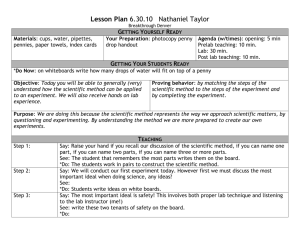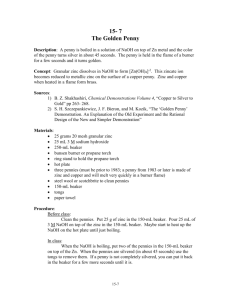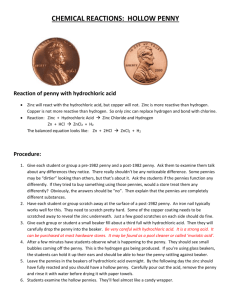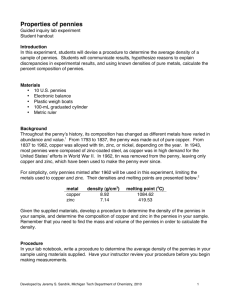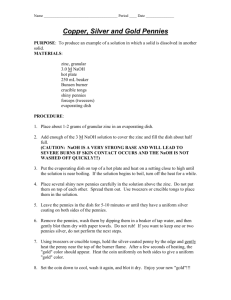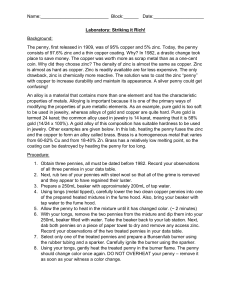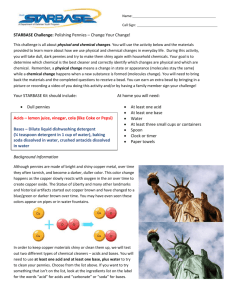Chemistry 101 Modesto Junior College Dr. Caddell DENSITY LAB
advertisement
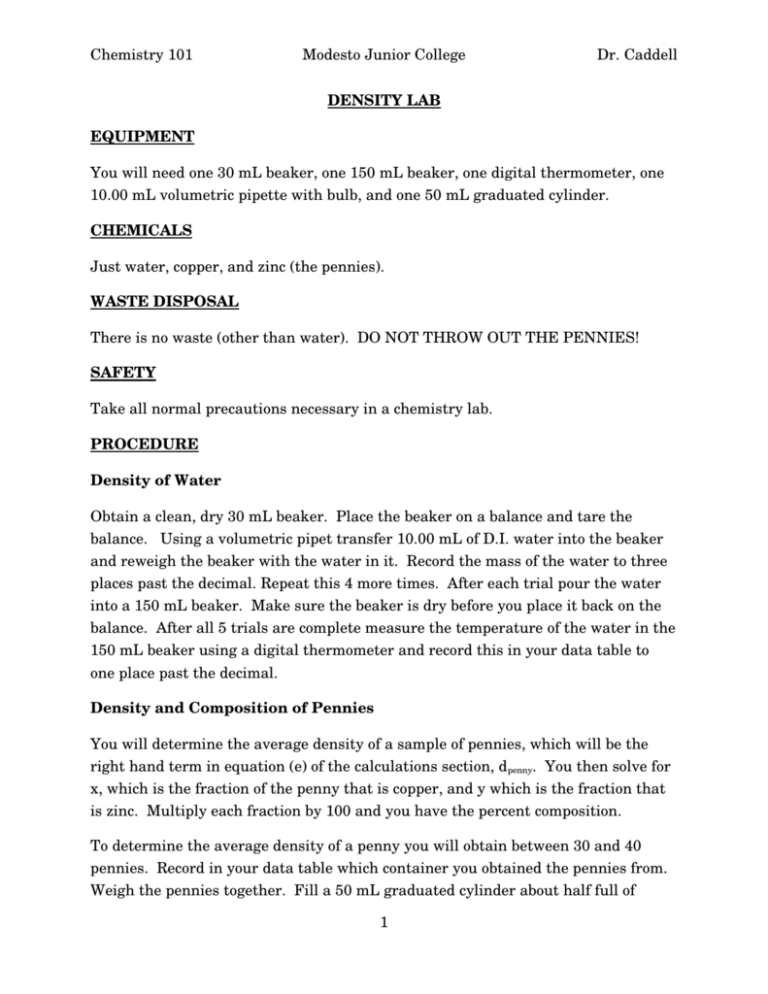
Chemistry 101 Modesto Junior College Dr. Caddell DENSITY LAB EQUIPMENT You will need one 30 mL beaker, one 150 mL beaker, one digital thermometer, one 10.00 mL volumetric pipette with bulb, and one 50 mL graduated cylinder. CHEMICALS Just water, copper, and zinc (the pennies). WASTE DISPOSAL There is no waste (other than water). DO NOT THROW OUT THE PENNIES! SAFETY Take all normal precautions necessary in a chemistry lab. PROCEDURE Density of Water Obtain a clean, dry 30 mL beaker. Place the beaker on a balance and tare the balance. Using a volumetric pipet transfer 10.00 mL of D.I. water into the beaker and reweigh the beaker with the water in it. Record the mass of the water to three places past the decimal. Repeat this 4 more times. After each trial pour the water into a 150 mL beaker. Make sure the beaker is dry before you place it back on the balance. After all 5 trials are complete measure the temperature of the water in the 150 mL beaker using a digital thermometer and record this in your data table to one place past the decimal. Density and Composition of Pennies You will determine the average density of a sample of pennies, which will be the right hand term in equation (e) of the calculations section, dpenny. You then solve for x, which is the fraction of the penny that is copper, and y which is the fraction that is zinc. Multiply each fraction by 100 and you have the percent composition. To determine the average density of a penny you will obtain between 30 and 40 pennies. Record in your data table which container you obtained the pennies from. Weigh the pennies together. Fill a 50 mL graduated cylinder about half full of 1 Chemistry 101 Modesto Junior College Dr. Caddell water (tap water is fine) and record the initial volume in your data table to one place past the decimal. Drop the pennies into the graduated cylinder one at a time, edgewise. Make sure to get any air pockets out from between the pennies. Record the final volume to one place past the decimal. The difference between the final volume and the initial volume is the volume of the pennies. Dry the pennies and return them TO THE SAME CONTAINER YOU OBTAINED THEM FROM. Calculations Density of Water Calculate the density of 10.00 mL of water for each of the five trials. Calculate the average density of the 5 trials. Calculate the percent error using the following table to find the accepted value for the density of water at your temperature. If your temperature falls between two of the values in the table then interpolate. For example, if the temperature of your water is 19.3 oC then the density of your water, dH2O, would be dH2O = 0.998405 g/mL – 0.3(0.998405 g/mL – 0.998203 g/mL) = 0.998344 g/mL. Density of H2O (g/mL) Temperature (oC) 0.998595 0.998405 0.998203 0.997992 0.997770 0.997538 0.997296 0.997044 0.996783 0.996512 0.996232 18 19 20 21 22 23 24 25 26 27 28 Using Microsoft Excel or LibreOffice Calc find the standard deviation for your 5 density values. To do this the command is the same in both programs: “=STDEV(____:___)” (without the quotes). You fill in the blanks with the addresses of the cells where you have your date, for example =STDEV(A1:A5) if you have your five densities in the first five cells in the spreadsheet. Report the first 2 nonzero digits in the result. 2 Chemistry 101 Modesto Junior College Dr. Caddell The percent error is a measure of the accuracy of your measurements. The smaller the percent error, the more accurate you were. The standard deviation is a measure of the precision of your experiments. The smaller the standard deviation, the more precise you were. The percent error is given by: |Experimental Value−True Value| ×100=% Error (a) True Value Here “Experimental Value” is the average of your five trials. The “True Value” is the value that you read from the above table. Density and Composition of Pennies In this portion of the experiment you determine the average density and percent composition of some pennies. Modern pennies are composed of copper and zinc. The density of a penny is the weighted average of the density of copper and the density of zinc. The weights are the fraction of the penny that is each metal. For example if a penny were 90.0% copper and 10.0% zinc, the density of the penny would be given by: d penny =0.900×8.96 g g + 0.100×7.13 3 3 cm cm (b) Here 8.96 g/cm3 is the density of pure copper and 7.13 g/cm3 is the density of pure zinc. These values should go in your table of constants. You will not initially know the fraction of the penny that is copper and the fraction that is zinc, so we can write: d penny =(x)×8.96 g g + ( y )×7.13 3 3 cm cm (c) Where x is the fraction of the penny that is copper and y is the fraction that is zinc. That is 2 unknowns and one equation; we need another equation to solve the problem. Because there are only 2 metals, we know that their fractions must add up to 1 (their percentages must add up to 100). That means we have our second equation: x + y = 1, or y = 1 − x (d) 3 Chemistry 101 Modesto Junior College Dr. Caddell Substituting equation (d) into equation (c) we get: d penny =(x)×8.96 g g + (1−x )×7.13 3 3 cm cm (e) Calculate the average density of a penny, dpenny, by dividing the total mass of the pennies you used by the volume they occupied. Make sure to show the subtraction that you used to get the volume of the pennies. The average density of a penny will then be given by: d pennies = masspennies volumepennies (f) Use this value in equation (e) to find the fraction copper (x), and substitute into equation to equation (d) to find the fraction zinc (y). Multiply each fraction by 100 to get the percent composition of the penny. CONCLUSION Density of water Report ­ your average density of water ­ your percent error ­ your standard deviation Discuss your results. Were you accurate? Were you precise? Give at least two possible sources of error, describe what effect each would have on your results, and explain why each would have that result. Density and composition of pennies Report ­ the average density of a penny ­ the percent composition of your pennies. Give at least two possible sources of error, describe what effect each would have on your results, and explain why each would have that result. 4
